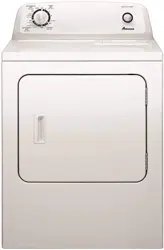Documents: Go to download!
User Manual
- User Manual - (English, French)
- Quick Start Guide - (English)
- Specification Sheet - (English)
- Cycle Guide - (English)
- Installation Instructions - (English)
- Dimension Guide - (English)
- CHECK YOUR VENT SYSTEM FOR GOOD AIR FLOW
- USE AUTOMATIC DRY CYCLES FOR BETTER FABRIC CARE AND ENERGY SAVINGS
- CONTROL PANEL & FEATURES
- CYCLE GUIDE — AUTOMATIC DRY CYCLES
- CYCLE GUIDE — TIMED DRY CYCLES
- USING YOUR DRYER
- DRYER CARE
- TROUBLESHOOTING
Table of contents
CHECK YOUR VENT SYSTEM FOR GOOD AIR FLOW

Fire Hazard
Use a heavy mental vent.
Do not use a plastic vent
Do not use a metal foll vent
Failure to follow these instruction can result in death or fire
Good air flow
Along with heat, dryers require good air flow to efficiently dry laundry. Proper venting will reduce your drying times and improve your energy savings. See “Installation Instructions.”
The venting system attached to the dryer plays a big role in good air flow.
Service calls caused by improper venting are not covered by the warranty and will be paid by the customer, regardless of who installed the dryer.
Maintain good air flow by:
■ Cleaning your lint screen before each load.
■ Replace plastic or foil vent material with 4" (102 mm) diameter heavy, rigid vent material

■ Use the shortest length of vent possible.
■ Use no more than four 90° elbows in a vent system; each bend and curve reduces air flow.
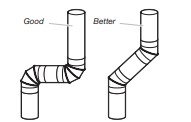
■ Remove lint and debris from the exhaust hood.
■ Remove lint from the entire length of the vent system at least every 2 years. When cleaning is complete, be sure to follow the “Installation Instructions” supplied with your dryer for final product check.
■ Clear away items from the front the dryer.
USE AUTOMATIC DRY CYCLES FOR BETTER FABRIC CARE AND ENERGY SAVINGS
Use the Automatic Dry cycles to provide the most energy savings and enhanced fabric care from the dryer. During Automatic Dry cycles, drying air temperature or moisture level are sensed in the load. This sensing occurs throughout the drying cycle and the dryer shuts off when the load reaches the selected dryness. The Energy Preferred cycle will provide optimal energy savings.
With Timed Dry, the dryer runs the amount of time set and sometimes results in shrinkage, wrinkling, and static due to over-drying. Use Timed Dry for the occasional damp load that needs a little more drying time or when using the drying rack.
CONTROL PANEL & FEATURES
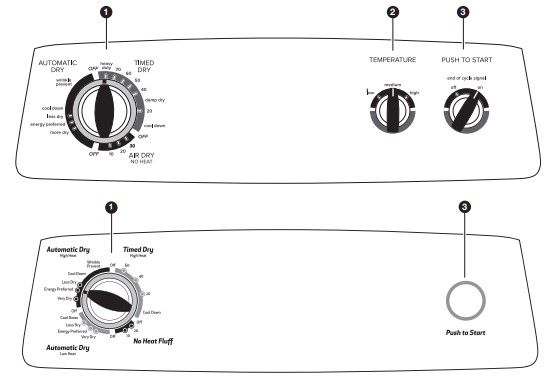
Not all features and options are available on all models. Appearance may vary.
1. DRYER CYCLE KNOB
Use your Dryer Cycle Knob to select available cycles on your dryer. Turn the knob to select a cycle for your laundry load. See “Cycle Guide” for detailed descriptions of cycles.
TIMED DRY
Will run the dryer for the specified time on the control. On models with a selectable temperature knob, you may choose a setting based on the fabrics in your load. Drying time and temperature will depend on your dryer model.
AUTOMATIC DRY
Senses moisture in the load or air temperature and shuts off when the load reaches the selected dryness level. Gives the best drying in the shortest time. Drying time will vary based on fabric type, load size, and dryness setting
2. TEMPERATURE
Select a drying temperature based on the fabrics in your load. If you are unsure of the temperature to select for a load, select the lower setting rather than the higher setting.
3. PUSH TO START/END OF CYCLE SIGNAL
The End of Cycle Signal produces an audible sound when the drying cycle is finished. Promptly removing clothes at the end of the cycle reduces wrinkling.
Turn the END OF CYCLE SIGNAL knob to select the desired setting (On or Off). Press the PUSH to START knob to start the dryer
CYCLE GUIDE — AUTOMATIC DRY CYCLES
1 Items to dry: Jeans, heavy work clothes, towels
Dryness Level: More Dry/Very Dry Energy Preferred Less Dry
Temperature: High
2 Items to dry: Work clothes, medium weight fabrics, sheets
Dryness Level: More Dry/Very Dry Energy Preferred Less Dry
Temperature: Medium
3 Items to dry: Casual, shirts, pants, lightweight items, synthetics, delicates, athletic wear
Dryness Level: More Dry/Very Dry Energy Preferred Less Dry
Temperature: Low
Cycle Details:
Automatic cycles give the best drying in the shortest time. Drying time varies based on fabric type, load size, and dryness setting.
Select a drying temperature based on the fabrics in your load. If you are unsure of the temperature to select for a load, select the lower setting rather than the higher setting.
NOTE: If loads do not seem as dry as you would like, select Very/More Dry next time you dry a similar load. If loads seem drier than you like, select Less Dry next time you dry a similar load.
CYCLE GUIDE — TIMED DRY CYCLES
Not all cycles and settings are available on all models.
TIMED DRY - Will run the dryer for the specified time on the control.
1 Items to dry:Large or heavy items such as thick towels or robes
Cycle: Heavy Duty/ Heavy Dry
Temperature: Any
Cycle Details: Choose high to dry large or heavy loads.
2 Items to dry: Any load
Cycle: Damp Dry
Temperature: Any
Cycle Details: Dries items to a damp level or for items that do not require an entire drying cycle.
3 Items to dry:Any load
Cycle: Tumble Press®
Temperature: Any
Cycle Details: Use low to medium temperature to smooth out wrinkles, such as those found in clothes packed in a suitcase or in items wrinkled from being left in the dryer too long.
4 Items to dry: Rubber, plastic, heat sensitive fabrics
Cycle: Air Dry/No Heat No Heat Fluff
Temperature: N/A
Cycle Details: No heat drying.
Setting the Drying Temperature.
If your dryer has multiple heat settings:
■ A High temperature setting may be used for drying heavyweight items such as towels and work clothes.
■ A Low to Medium temperature setting may be used for drying medium-weight items such as sheets, blouses, dresses, underwear, permanent press fabrics, and some knits.
■ Use the Air Dry/No Heat or No Heat Fluff setting for foam, rubber, plastic, or heat-sensitive fabrics.
■ Line dry bonded or laminated fabrics.
NOTE: If you have questions about drying temperatures for various loads, refer to the care label directions.
USING YOUR DRYER

Explosion Hazard
Keep Flammable materials and vapors, such as gasoline, away from dryer
do not dry anything that has ever had anything flammable on it (even after washing)
Failure to follow these instructions can result in death, explosion, or fire

Fire Hazard
No washer can completely remove oil
do not dry anything that has ever had any type of oil on it (including cooking oil)
Items containing foam, rubber, or plastic must be dried on a clothesline or by using an Air Cycle
Failure to follow these instructions can result in death , or fire.
WARNING: To reduce the risk of fire, electric shock, or injury to persons, read the IMPORTANT SAFETY INSTRUCTIONS before operating this dryer.
Before using your dryer, wipe the dryer drum with a damp cloth to remove dust from storing and shipping.
1. Clean the lint screen
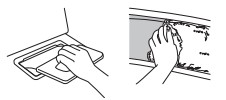
Clean the lint screen before each load. Pull the lint screen out of its holder. Roll lint off the screen with your fingers. Do not rinse or wash screen to remove lint. Push the lint screen firmly back into place. For additional cleaning information, see “Dryer Care”.
2. Load the dryer.
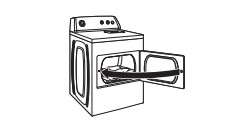
Place laundry in the dryer. Close the door. Do not tightly pack the dryer; clothes should be able to tumble freely.
NOTE: Your model may have a different door than the one shown. Some models have drop down doors.
3. Select the desired cycle
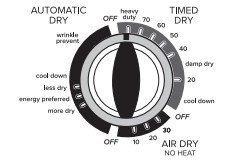
Select the desired cycle for your load. See the Cycle Guide for more information about each cycle.
AUTOMATIC DRY Cycles
You can select a different dryness level, depending on your load, by turning the knob to dryness level.
Selecting Very Dry, ENERGY PREFERRED, or Less Dry automatically adjusts the dryness level at which the dryer will shut off. Once a dry level is set, it cannot be changed without stopping the cycle.
AUTOMATIC DRY cycles give the best drying in the shortest time. Drying time varies based on fabric type, load size, and dryness setting
4. Set cycle settings and options
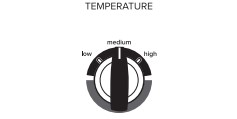
Select cycle settings and options by turning the knob to the desired position.
NOTE: Not all options and settings are available with all cycles.
5. Select End of Cycle Signal (depending on model)

Turn the END OF CYCLE SIGNAL knob to select the desired setting (On or Off). The End of Cycle Signal produces an audible sound when the drying cycle is finished. Promptly removing clothes at the end of the cycle reduces wrinkling.
6. Press PUSH to START to begin cycle (appearance may vary)

Push and hold the PUSH to START knob to begin the cycle.
DRYER CARE
CLEANING THE DRYER LOCATION
Keep dryer area clear and free from items that would block the air flow for proper dryer operation. This includes clearing piles of laundry in front of the dryer.

Explosion Hazard
Keep Flammable materials and vapors, such as gasoline, away from dryer.
Place Dryer at least 18 inches (460 mm) above the floor for a garage installation.
Failure to follow these instructions can result in death, explosion, or fire.
CLEANING THE DRYER INTERIOR
To clean dryer drum
1. Apply a liquid, nonflammable household cleaner to the stained area of the drum and rub with a soft cloth until stain is removed.
2. Wipe drum thoroughly with a damp cloth.
3. Tumble a load of clean cloths or towels to dry the drum.
NOTE: Garments that contain loose dyes, such as denim blue jeans or brightly colored cotton items, may discolor the dryer interior. These stains are not harmful to your dryer and will not stain future loads of clothes. Dry these items inside out to avoid drum staining.
REMOVING ACCUMULATED LINT
From inside the dryer cabinet
Lint should be removed every 2 years, or more often, depending on dryer usage. Cleaning should be done by a qualified servicer.
From the exhaust vent
Lint should be removed every 2 years, or more often, depending on dryer usage.
CLEANING THE LINT SCREEN
Every load cleaning
The lint screen is located in the dryer. A screen blocked by lint can increase drying time.
To clean:
1. Pull the lint screen out of its holder. Roll lint off the screen with your fingers. Do not rinse or wash screen to remove lint. Wet lint is hard to remove.
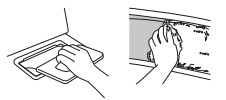
2. Push the lint screen firmly back into place.
CLEANING THE LINT SCREEN
2. Push the lint screen firmly back into place.
IMPORTANT:
■ Do not run the dryer with the lint screen loose, damaged, blocked, or missing. Doing so can cause overheating and damage to both the dryer and fabrics.
■ If lint falls off the screen into the dryer during removal, check the exhaust hood and remove the lint. See “Venting Requirements.”
As needed cleaning
Laundry detergent and fabric softener residue can build up on the lint screen. This buildup can cause longer drying times for your clothes, or cause the dryer to stop before your load is completely dry. The screen is probably clogged if lint falls off while the screen is in the dryer.
Clean the lint screen with a nylon brush every 6 months, or more frequently, if it becomes clogged due to a residue buildup.
To wash:
1. Roll lint off the screen with your fingers.
2. Wet both sides of lint screen with hot water.
3. Wet a nylon brush with hot water and liquid detergent. Scrub lint screen with the brush to remove residue buildup.

4. Rinse screen with hot water.
5. Thoroughly dry lint screen with a clean towel. Reinstall screen in dryer.
VACATION, STORAGE, AND MOVING CARE
Non-Use or Storage Care
Operate your dryer only when you are at home. If you will be on vacation or not using your dryer for an extended period of time, you should:
1. Unplug dryer or disconnect power.
2. (For gas dryers only): Close shut off valve to gas supply line.
3. Clean lint screen. See “Cleaning the Lint Screen.”
Moving Care
For power supply cord-connected dryers:
1. Unplug the power supply cord.
2. Make sure leveling legs are secure in dryer base.
3. Use tape to secure dryer door.

Electrical Shock Hazard
Disconnect power before servicing.
Replace all parts and panels before operating.
Failure to follow these instructions can result in death or electrical shock.
For direct-wired dryers:
1. Turn off power at fuse or breaker box.
2. Disconnect wiring.
3. Make sure leveling legs are secure in dryer base.
4. Use tape to secure dryer door.
For gas dryers:
1. Unplug or disconnect power to dryer.
2. Close shutoff valve in gas supply line.
3. Disconnect gas supply line pipe and remove fittings attached to dryer pipe.
4. Cap the open fuel supply line.
5. Make sure leveling legs are secure in dryer base.
6. Use tape to secure dryer door.
Reinstalling the Dryer
Follow the “Installation Instructions” to locate, level, and connect the dryer.
CHANGING THE DRUM LIGHT (ON SOME MODELS)
1. Unplug dryer or disconnect power.
2. Open the dryer door. Locate the light bulb cover on the back wall of the dryer. Using a 1/4" nut driver or socket wrench, remove the screw located in the lower right-hand corner of the cover. Remove the cover.
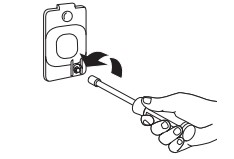
3. Turn bulb counterclockwise. Replace the bulb with a 10-watt appliance bulb only. Replace the cover and secure with the screw.
4. Plug into a grounded outlet or reconnect power.
TROUBLESHOOTING
To possibly avoid a service call, first try the suggestions listed here or refer to the “Assistance or Service” page.
If you experience - Possible Causes - Solution
1. Clothes are not drying satisfactorily, drying times are too long
- Lint screen clogged with lint : Lint screen should be cleaned before each load.
- Has the Air Only cycle been selected: Select the right cycle for the types of garments being dried. See “Cycle Guide.”
- Load too large and heavy to dry quickly : Separate the load to tumble freely.
- Exhaust vent or outside exhaust hood clogged with lint, restricting air movement. : Run the dryer for 5-10 minutes. Hold your hand under the outside exhaust hood to check air movement. If you do not feel air movement, clean exhaust system of lint or replace exhaust vent with heavy metal or flexible metal vent. Make sure vent is not crushed or kinked. See “Installation Instructions”.
- Fabric softener sheets blocking the grill: Use only one fabric softener sheet, and use it only once.
- Exhaust vent not the correct length : Check that the exhaust vent is not too long or has too many turns. Long venting will increase drying times. Make sure vent is not crushed or kinked. See “Installation Instructions”.
- Exhaust vent diameter not the correct size. : Use 4" (102 mm) diameter vent material.
- Dryer located in a room with temperature below 45ºF (7ºC)? : Proper operation of dryer cycles requires temperatures above 45ºF (7ºC).
- Dryer located in a closet without adequate opening. : Closet doors must have ventilation openings at the top and bottom of the door. The front of the dryer requires a minimum of 1" (25 mm) of airspace, and, for most installations, the rear of the dryer requires 5" (127 mm). See “Installation Instructions”.
2. Dryer will not run.
- Door not closed completely : Make sure the dryer door is closed completely.
- Household fuse is blown or circuit breaker has tripped: Electric dryers use 2 household fuses or circuit breakers. The drum may be turning, but you may not have heat. Replace both fuses or reset the circuit breaker. If the problem continues, call an electrician.
- PUSH to START knob not pressed firmly or held long enough: Press and hold the PUSH to START knob until you hear the dryer drum moving.
- Incorrect power supply: Electric dryers require 240-volt power supply. Check with a qualified electrician.
- Wrong type of fuse: Use a time-delay fuse
3. Unusual sounds
- Dryer had a period of non-use : If the dryer hasn’t been used for awhile, there may be a thumping sound during the first few minutes of operation.
- A coin, button, or paper clip caught between the drum and front or rear of the dryer: Check the front and rear edges of the drum for small objects. Clean out pockets before laundering.
- It is a gas dryer: The gas valve clicking is a normal operating sound.
- All four legs are not installed, dryer not level front to back and/or side to side: The dryer may vibrate if not properly installed. See “Installation Instructions”.
No heat
- Household fuse is blown or circuit breaker has tripped : The drum may be turning, but you may not have heat. Electric dryers use 2 household fuses or circuit breakers. Replace both fuses or reset the circuit breaker. If the problem continues, call an electrician.
- Supply line valve not open: For gas dryers, is the valve open on the supply line.
- Incorrect power supply: Electric dryers require 240-volt power supply. Check with a qualified electrician.
4. Cycle time too short
- Automatic cycle ending early: The load may not be contacting the sensor strips. Level the dryer. Use Timed Dry for very small loads. Change the Dry Level setting on Automatic Dry cycles. Increasing or decreasing the Dry Level setting will change the amount of drying time in a cycle.
5. Lint on load
- Lint screen clogged: Lint screen should be cleaned before each load.
6. Stains on load or drum
- Dryer fabric softener not properly used: Add dryer fabric softener sheets at the beginning of the cycle. Fabric softener sheets added to a partially dried load can stain your garments. Drum stains are caused by dyes in clothing (usually blue jeans). These will not transfer to other clothing.
7. Loads are wrinkled:
- Dryer tightly packed: Dry smaller loads that can tumble freely reduce wrinkles from forming.
8. Odors
- Recent painting, staining, or varnishing in the area where your dryer is located: If so, ventilate the area. When the odors or fumes are gone from the area, rewash and dry the clothing.
- Dryer being used for the first time: The new electric heating element may have an odor. The odor will be gone after the first cycle
9. Load is too hot.
- Laundry items removed from the dryer before the end of the cycle: Allow Cool Down cycle to finish before removing laundry from dryer. All cycles are cooled slowly to reduced wrinkling and make it easier to handle. Items removed before Cool Down may feel very warm
- High temperature cycle used or was TEMPERATURE control set to high: Select a lower temperature, and use an automatic drying cycle. These cycles sense the temperature or the moisture level in the load and shut off when the load reaches the selected dryness. This reduces overdrying.
See other models: ACC6340KFB AEC6540KFB ACC6356KFB AWO6317SFB AWO6313SFS
